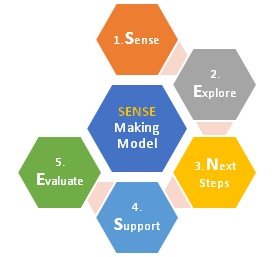A Coaching Model Created by Robert Letchford
(Leadership and Org Development, MYANMAR)
Introduction
During the time that I have been working on my ICA coaching accreditation, I have tried to focus my mind on coaching practice and/or ‘niche’ that I am passionate about and that would add value in my consultations with clients. To that end, I believe that as per the ICA coaching program a structured approach would provide the most benefit to clients that I want to engage with. I want to focus my coaching practice (niche) on working with Leadership and Managers of organizations to assist them to ‘make sense, of the complex working environments within which they work.
Leadership and managers of organizations today work in complex and fast-moving environments with little or limited opportunity to reflect and ‘make sense of the situations that they are managing. The Cynefin Framework[1], which is based on ‘complexity theory’[2]and ‘systems thinking[3]suggests that leaders and manager can make better decisions[4], that have meaningful and long-lasting impacts if they can ‘make sense of their environments and respond appropriately.
The SENSE-making coaching model that I have developed below is informed by my understanding of the ‘complexity theory’, ‘systems thinking and the Cynefin Framework combined with what I have learned during my journey on the ICA Certified Professional Coach (CPC) program.
The SENSE Making Coaching Model
The ‘SENSE’ Making Coaching Model that I have developed is a framework that consists of five (5)phases.
- Sense: At the beginning of each coaching session time is provided for the client to discuss the topic that they are bringing to the session. This allows time for the client and coach to sense what needs to be discussed or addressed (topic) during the coaching session.
- Explore: After the coach and client have agreed (sensed) the topic to be discussed, time is dedicated to exploring the topic and allow the client to ‘make sense of the topic that has been brought to the coaching session. This exploration enables the client to not only ‘make sense of the topic, but also explore their feelings about the topic and identify possible solutions or actions that the client would like to implement.
- Next Steps: After exploring the topic (issue/problem/challenge), making sense of it, and identifying possible solutions or actions, time in the coaching session is then taken to work with the client to agree on the next steps that the client would like to take. The coach will work with the client to clarify (if not already) the next steps that need to be taken to implement the solution(s) or action(s) identified by the client during the coaching session. This may entail, assisting the client to identify the timing, specific actions, flow (steps), and resources required to ensure ‘next steps are implemented.
- Support: After identifying the next steps and detailing them, the coach assists the client to assess if they require any other support, be it from the coach or other sources. This part of the coaching session is also utilized to assist the client to think about possible roadblocks that they might encounter during the implementation of their ‘next steps. The coach works with the client to understand how identified support(s) and/or other resources identified by the client can be utilized to ensure roadblocks, don’t get in the way of solutions/actions (next steps) being implemented.
- Evaluate: At the end of the coaching session the coach encourages the client to evaluate what they have learned about themselves and the issue/problem/challenge (topic) that they brought to the coaching session. This can also lead to re-evaluation or continued coaching discussion in another session. That is, the Evaluate part of one coaching session can flow into the next SENSE-making coaching session. The SENSE-making coaching model is then a coaching model that aligns with concepts of ‘adult learning’ and ‘continuous learning’.
Refection
Below are some questions that can be used to solicit reflection and/or assist clients to ‘make sense of their environment and build their own personal self-awareness of the ‘world’ they live in and how they ‘locate’ themselves in it.
- What do you need to ‘make sense of during this coaching session?
- What does ‘making sense’ mean to you?
- What will ‘making sense of this problem/situation give you that you don’t have now?
- What will success look like when you have ‘made sense of this situation/problem?
- What have you learned from ‘making sense of this situation/problem?
References
- The Cynefin Framework,https://www.youtube.com/watch?v=N7oz366X0-8
- What is Complexity Theory and How Can it Improve the Workplace? https://agile-mercurial.com/2019/05/13/what-is-complexity-theory-and-how-can-it-improve-the-workplace/
- Systems Thinking is Leadership, https://thesystemsthinker.com/%EF%BB%BFsystems-thinking-is-leadership/
- Cynefin Framework for Decision Making, https://hbr.org/2007/11/a-leaders-framework-for-decision-making
- ICA Frameworks and Models: https://learnsite.icacoach.com/english-campus/frameworks-models-course/